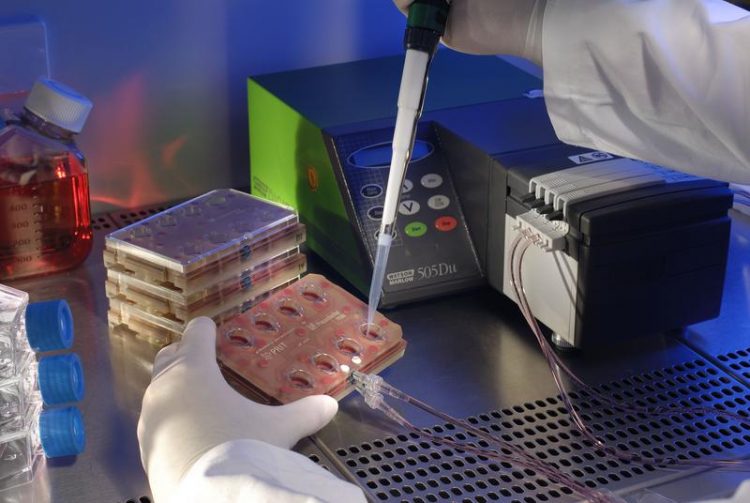Toxicology in flux – Fraunhofer ITEM is participating in the European research project “EU-ToxRisk”

The Fraunhofer P.R.I.T. ®-ExpoCube® exposure system allows to study airborne substances by exposing cells or vital tissue samples from the respiratory tract directly at the air/liquid interface. Photo: R. Meier / Fraunhofer ITEM
The European Commission is funding this large-scale project “EU-ToxRisk” under its research and innovation funding scheme “Horizon 2020”. The aim is to integrate the results of the research project into future regulatory chemical safety and risk assessment and to establish new assessment concepts – not only in Europe, but worldwide. These new concepts will involve cutting-edge, human-relevant in-vitro non-animal methods and in-silico computational technologies to translate molecular mechanistic understanding of toxicity into safety testing strategies.
“We are breaking new ground in toxicology, towards mechanism-based toxicological assessment. In-vitro methods, those that are human-relevant in particular, and in-silico methods are playing a crucial role in this paradigm shift. In-silico approaches today are no longer limited to deriving the toxicity of a substance from its structure, but also include toxicity and effect profiles,” says Dr. Annette Bitsch, head of the Fraunhofer ITEM Division of Chemical Risk Assessment. She and her team will bring to this EU project their expertise in inhalation toxicology in particular, which is the specialty of the Fraunhofer researchers.
The Fraunhofer scientists will contribute the experience they have gained with alternative methods in evaluating inhalation toxicity. For example, the P.R.I.T. ®-ExpoCube® exposure system developed at the Fraunhofer ITEM allows them to study airborne substances by exposing cells or vital tissue samples from the respiratory tract directly at the air/liquid interface. Suitable in-vitro or ex-vivo models are cultures of cells from the respiratory tract or vital lung tissue samples of human or animal origin, precision-cut lung slices (PCLS) in particular.
With its broad experience gained during development and application of toxicological databases and the use of read-across methods in regulatory contexts, the Fraunhofer ITEM can make an important contribution to the EU-ToxRisk project, in particular by developing in-silico methods.
Coordinated by Bob van de Water, Professor of Toxicology at Leiden University (The Netherlands), EU-ToxRisk intends to become the European flagship for animal-free chemical safety assessment. The project will integrate advancements in cell biology, “omics” technologies, systems biology and computational modelling to define the complex chains of events that link chemical exposure to toxic outcome. The consortium will provide proof of concept for a new mechanism-based chemical safety testing strategy with a focus on repeated-dose systemic toxicity as well as developmental and reproductive toxicity. Importantly, novel mechanism-based test methods will be integrated into fit-for-purpose testing batteries that are in line with the regulatory framework and will meet the requirements of industrial implementation. EU-ToxRisk will develop new quantitative risk assessment approaches based on understanding of so-called “Adverse Outcome Pathways” incorporating all mechanistic toxicity data available in the public domain. It will also achieve a rapid improvement of so-called “read across” approaches, to allow existing data gaps to be filled by means of alternative methods.
Contact
Fraunhofer ITEM
Dr. Annette Bitsch; +49 511 5350-302
annette.bitsch@item.fraunhofer.de
Press contact
Fraunhofer ITEM
Dr. Cathrin Nastevska; +49 511 5350-225
cathrin.nastevska@item.fraunhofer.de
The text of this press release including an image for download can be found on our homepage at
http://www.item.fraunhofer.de/en/press-media/latest-news/pm-toxikologieimwandel….
Media Contact
All latest news from the category: Awards Funding
Newest articles

Silicon Carbide Innovation Alliance to drive industrial-scale semiconductor work
Known for its ability to withstand extreme environments and high voltages, silicon carbide (SiC) is a semiconducting material made up of silicon and carbon atoms arranged into crystals that is…

New SPECT/CT technique shows impressive biomarker identification
…offers increased access for prostate cancer patients. A novel SPECT/CT acquisition method can accurately detect radiopharmaceutical biodistribution in a convenient manner for prostate cancer patients, opening the door for more…

How 3D printers can give robots a soft touch
Soft skin coverings and touch sensors have emerged as a promising feature for robots that are both safer and more intuitive for human interaction, but they are expensive and difficult…





















